User Guide
KINAMU Business Solutions GmbH
Talpagasse 1A | A-1230 Wien
www.kinamu.com | office@kinamu.com | Tel: +43 1 306 20-0
KINAMU Field Service Management Addon
for the integration of field service management processes into SugarCRM
Vienna, January 2025
Version 1.0
Modules Overview
Service Orders
The Service Orders module keeps track of the employees responsible for service tasks. It allows businesses to manage their field service personnel, including their skills and assignments.
Service Agreements
The Service Agreements module manages the agreements made with customers for providing services. It stores details about the scope of the agreement, the duration, and other special terms.
Equipments
The Equipments module manages the assets that are subject to service tasks. It keeps track of the equipment and its individual components.
Service Locations
The Service Locations module manages the locations where services are provided. It can include customer sites, service centers, or any other place where field service operations are performed.
Service Plans
The Service Plans module defines the frequency and validity of the services offered under a service agreement. They can be set to various intervals (daily, monthly, yearly or also non-periodically).
Task Templates
The Task Templates module defines a template for a SugarCRM Task. These templates are used by the scheduler backend to create service orders and related SugarCRM tasks based on the templates according to service plan intervals.
Spare Parts
For each equipment and its components, the Spare Parts module keeps records of the spare parts required for maintenance and repair tasks.
Inventory Locations
The Inventory Locations module keeps track of where the inventory is stored. It can be used to manage stock in warehouses, service vehicles, or any other storage locations.
Inventory Stocks
The Inventory Stocks module allows businesses to monitor the quantity of inventory available at each location. It ensures that stock levels are optimized and that service tasks are not delayed due to missing parts.
Service Employees
The Service Employes module allows businesses to create and assign staff members to the field service management flow.
Service Recordings
The Service Recordings module enables recording of service employees activities during a service task.
Inventory Movements
The Inventory Movements module tracks the movement of inventory items between different locations.
Dispatcher
The Dispatcher module let the user assign tasks to service employees and organise them as daily schedule on a visually intuitive interface.
Scheduler
The Scheduler module automatically creates Service Orders and corrsponding tasks in the background.
Field Service Management Tree View
The Field Service Management Tree View Module lets the user to see the field service data structure in a tree-like visual style.
Basic Controls
The KINAMU Field Service Management addon uses the default Sugar UI. You can open the related modules by using the Sugar Navigation. The Subpanels can be used like any other Sugar core module.
The nav-menu exposed Modules are Service Orders, Inventory Locations and Service Employees. You can reach additional functionality inside these menus.
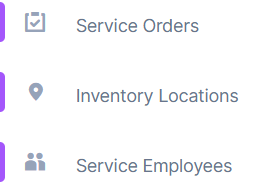
|
||
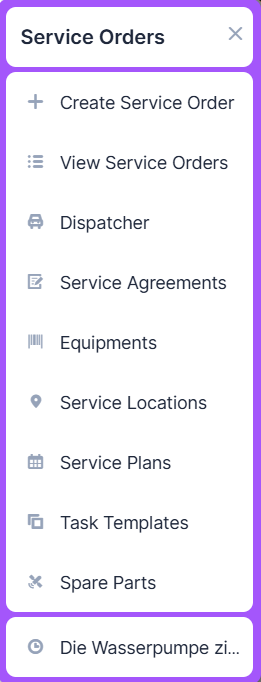
|
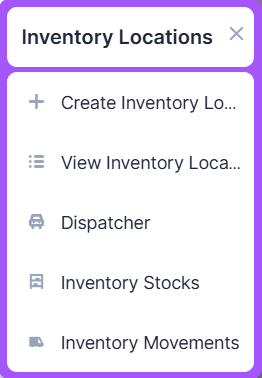
|
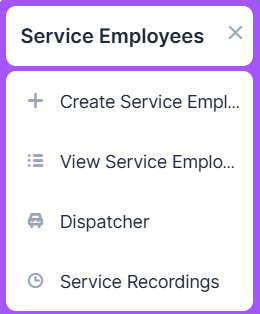
|
Subpanels connected to the Field Service Management Addon
Accounts
The Accounts subpanel shows Account items related to the view containing the panel.

The displayed data are:
- Name
- City
- Billing Country
- Phone
Business Centers
The Business Centers subpanel shows Business Center items related to the view containing the panel.

The displayed data are:
- Name
- Timezone
Cases
The Cases subpanel shows Case items related to the view containing the panel.

The displayed data are:
- Case Number
- Subject
- Account Name
- Status
- Date Created
- Assigned User
Equipments
The Equipments subpanel shows Equipment items related to the view containing the panel.

The displayed data are:
- Name
- Serial Number
- Service Location Name
- Installation Data
- Date Modified
A special appearance of the subpanel is the display of hierarchy inside the Equipments module. In this case, the subpanel shows further Equipment parts of the parent Equipment:

Inventory Locations
The Inventory Locations subpanel shows Equipment items related to the view containing the panel.

The displayed data are:
- Name
- Date Modified
Inventory Movements
The Inventory Movements subpanel shows Invenory Movement items related to the view containing the panel.

The displayed data are:
- Name
- Date Modified
Inventory Stocks
The Inventory Stocks subpanel shows Inventory Stocks items related to the view containing the panel.

The displayed data are:
- Name
- Date Modified
Service Employees
The Service Employees subpanel shows Service Employee items related to the view containing the panel.

The displayed data are:
- Name
- Date Modified
Service Locations
The Service Locations subpanel shows Service Location items related to the view containing the panel.

The displayed data are:
- Name
- Date Modified
A special appearance of the subpanel is the display the connections inside the Service Locations module. In this case, the subpanel shows Service Locations associated with the actual Service Location:

Service Orders
The Service Orders subpanel shows Service Order items related to the view containing the panel.

The displayed data are:
- Name
- Type
- Status
- Service Agreement Name
- Account Name
- Case Name
- Date Modified
Service Plans
The Service Plans subpanel shows Service Plan items related to the view containing the panel.

The displayed data are:
- Name
- Service Agreement Name
- Service Period
- Last Service
- Date Modified
Service Recordings
The Service Recordings subpanel shows Service Recording items related to the view containing the panel.

The displayed data are:
- Name
- Service Employee Name
- Task Name
- Date Modified
Task Templates
The Task Templates subpanel shows Task Template items related to the view containing the panel.

The displayed data are:
- Name
- Date Modified
Tasks
The Tasks subpanel shows Task items related to the view containing the panel.

The displayed data are:
- Subject
- Status
- Contact Name
- Start Date
- Due Date
- Assigned User Name
Licence Installation
After installing the Field Service Management Module, a new section appears on the SugarCRM admin panel, called "Kinamu Field Service Management". It contains only one function, the license configuration.

After clicking the above function, the Licence Management Module shows up and asks for a valid licence code. To perform the licence check, enter (or paste) a valid licence code and click the Validate button.
In case the licence check was successful and the licence code is valid, the form seems like this:

In case the licence check was successful but the licence code is valid, the form seems like this:

The Field Service Management modules can be reached without a valid licence code but in case of data creation attempts, error messages appear.
Modules Details
Service Orders
Module-specific Fields
- Case (represented on the UI with its name)
- Service Agreement (represented on the UI with its name)
- Account (represented on the UI with its name)
- Task type - selectable from a list of predefined values
- Closing Note
- Status - selectable from a list of predefined values
- Problem description
- Solution description
- Priority - selectable from a list of predefined values (Low / Medium / High)
- Billable? (yes / no)
- Equipment condition - selectable from a list of predefined values
- Start date (planned)
- End date (planned)
- Actual start date
- Actual end date
- Estimated durations - cannot be modified by the user; it calculates a rollback summary of task durations
Service Orders List View
This view displays the actual list of service orders.

Subpanels
The following associated data are displayed as subpanels in list view (detailed in the "Subpanels" section):
- Notes
- Tasks
Service Orders Record View
By clicking a service order in list view, the record view of the actual item shows up.

Convert SugarCRM Case to Service Order
One way to create service orders is to use SugarCRM cases and convert them to service orders (keepeing the original case, extended with a 'converted' flag). This can be achived by clicking the case record's "Convert To Service Order" button at the header. By doing this, a conversion form appears.

After filling the appropriate standard SugarCRM and specific service order fields, click the "Save and convert" button at the top to finish the service order creation.
Create Service Orders (From Service Orders Module)
By clicking the "Create" button at the top in the service orders' list view, an input form shows up.
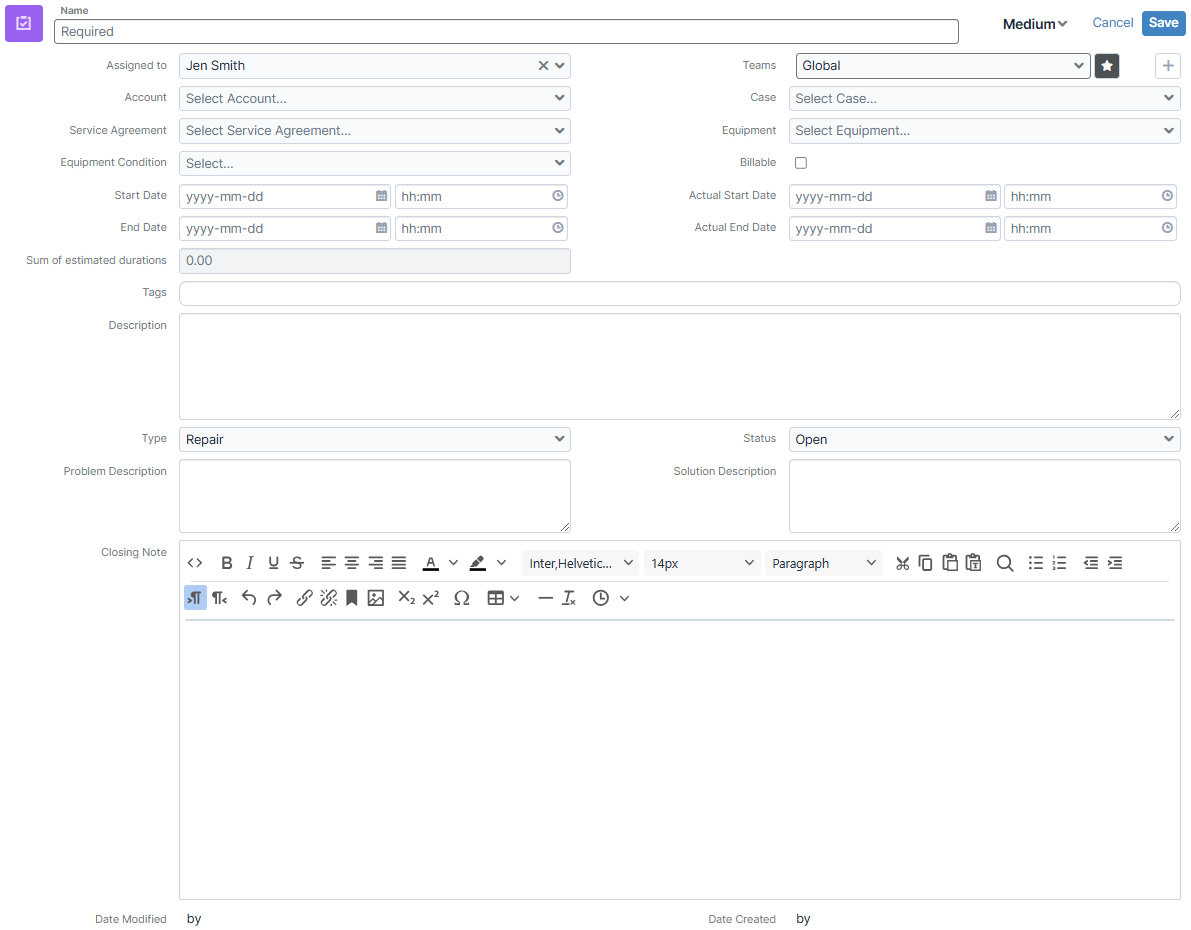
Fill in the appropriate standard SugarCRM and specific service order fields, click the "Save" button. The following fields are mandatory:
- Name
Service Agreements
Module-specific Fields
- Account (represented on the UI with its name)
- SLA Type - selectable from a list of predefined values
- Service Start Date
- Service End Date
- Expired? (yes / no)
- Status - selectable from a list of predefined values
- Service Agreement (represented on the UI with its name)
- Account (represented on the UI with its name)
Service Agreements List View
This view displays the actual list of service agreements.

Subpanels
The following associated data are displayed as subpanels in list view (detailed in the "Subpanels" section):
- Equipments (special appearance, with collecting all the equipments from all of the related service plans)
- Service Plans
- Service Orders
Service Agreements Record View
By clicking a service agreement in list view, the record view of the actual item shows up.

Create Service Agreements
By clicking the "Create" button at the top in the service agreements' list view, an input form shows up.
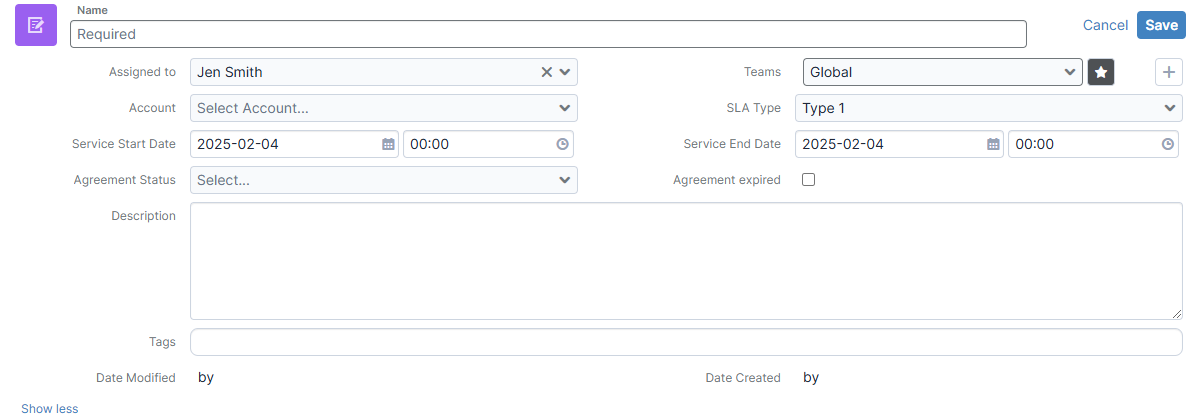
Fill in the appropriate standard SugarCRM and specific service agreement fields, click the "Save" button. The following fields are mandatory:
- Name
Create Missing Service Orders And Tasks According To Service Plan Schedules
Normally, the scheduler only creates service orders and tasks that comply with service agreements and service plans that are active and valid in terms of time. Furthermore, the scheduler always processes only the next upcoming events relative to the most recent service event.
If one or more scheduled task creations are missed, the continuity of task creation (service orders and SugarCRM tasks) is disrupted.
In this case, the missed tasks can be created manually. This can be done separately for each service agreement. To achieve this, click the button named "Create Service Orders" at the top of the service agreement's record view:

Equipments
Module-specific Fields
- Service Location (represented on the UI with its name)
- Service Task (represented on the UI with its name)
- Parent Equipment (represented on the UI with its name)
- Status - selectable from a list of predefined values
- Serial Number
- Product Type - selectable from a specific list of predefined values
- Product Category - selectable from a list of predefined values
- Product Number - selectable from a list of predefined values
- Installation Date
- Manufacturer Warranty Type - selectable from a list of predefined values
- Manufacturer Warranty Start Date
- Manufacturer Warranty End Date
- Customer Warranty Type - selectable from a list of predefined values
- Customer Warranty Start Date
- Customer Warranty End Date
- Manufacturer Country
- Year Of Manufacture
- Month Of Manufacture
Equipments List View
This view displays the actual list of equipments.

Subpanels
The following associated data are displayed as subpanels in list view (detailed in the "Subpanels" section):
- Cases
- Equipments (a special appearance as "Parts" - containing the sub-parts of the actual equipments)
- Service Plans
- Service Orders
Equipments Record View
By clicking an equipment in list view, the record view of the actual item shows up.

Create Equipments
By clicking the "Create" button at the top in the equipments' list view, an input form shows up.
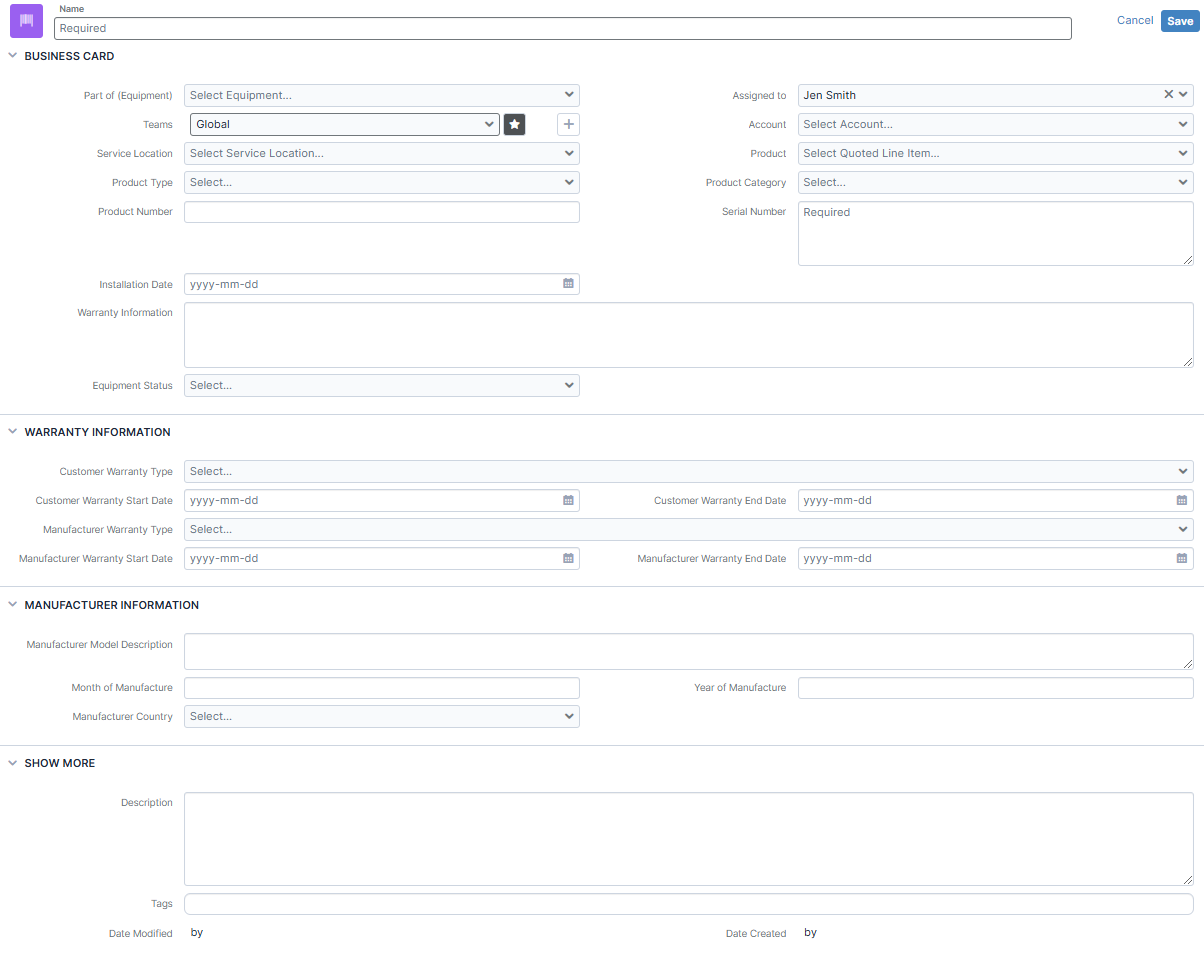
Fill in the appropriate standard SugarCRM and specific equipment fields, click the "Save" button. The following fields are mandatory:
- Name
- Serial Number
Service Locations
Module-specific Fields
- Account (represented on the UI with its name)
- Branch Address (with separated country, state, zip, city and street fields)
- Location Number
- Parent Service Location - selectable from previously recorded or newly added service locations
Service Locations List View
This view displays the actual list of service locations.

Subpanels
The following associated data are displayed as subpanels in list view (detailed in the "Subpanels" section):
- Equipments
- Business Centers
- Service Employees
- Associated Service Locations (a special appearance, containing all service locations which are related to the actual service location)
Service Locations Record View
By clicking a service location in list view, the record view of the actual item shows up.

Create Service Locations
By clicking the "Create" button at the top in the service locations' list view, an input form shows up.

Fill in the appropriate standard SugarCRM and specific service location fields, click the "Save" button. The following fields are mandatory:
- Name
Service Plans
Module-specific Fields
- Service Agreement (represented on the UI with its name)
- Service Duration Value
- Service Duration Unit
- Last Service
- Servicing Date Offset - service start date delays with this amount of days
Service Plans List View
This view displays the actual list of service plans.

Subpanels
The following associated data are displayed as subpanels in list view (detailed in the "Subpanels" section):
- Equipments
- Task Templates
Service Plans Record View
By clicking a service plan in list view, the record view of the actual item shows up.

Create Service Plans
By clicking the "Create" button at the top in the service plans' list view, an input form shows up.

Fill in the appropriate standard SugarCRM and specific service plan fields, click the "Save" button. The following fields are mandatory:
- Name
- Lead Time
- Service Every (but only in case if a time unit was chosen)
Task Templates
Task Templates List View
This view displays the actual list of task templates.

Subpanels
The following associated data are displayed as subpanels in list view (detailed in the "Subpanels" section):
- Service Plans
Task Templates Record View
By clicking a service plan in list view, the record view of the actual item shows up.

Create Task Templates
By clicking the "Create" button at the top in the task template' list view, an input form shows up.

Fill in the appropriate standard SugarCRM fields, click the "Save" button. The following fields are mandatory:
- Name
Spare Parts
Actually, it's a special type of product, holding a serial number.
Module-specific Fields
- Serial Number
Spare Parts List View
This view displays the actual list of spare parts (including SugarCRM products).

Subpanels
The following associated data are displayed as subpanels in list view (detailed in the "Subpanels" section):
- Tasks
Spare Parts Record View
By clicking a spare part (SugarCRM product) in list view, the record view of the actual item shows up.

Create Spare Parts
By clicking the "Create" button at the top in the spare parts' list view, an input form shows up.
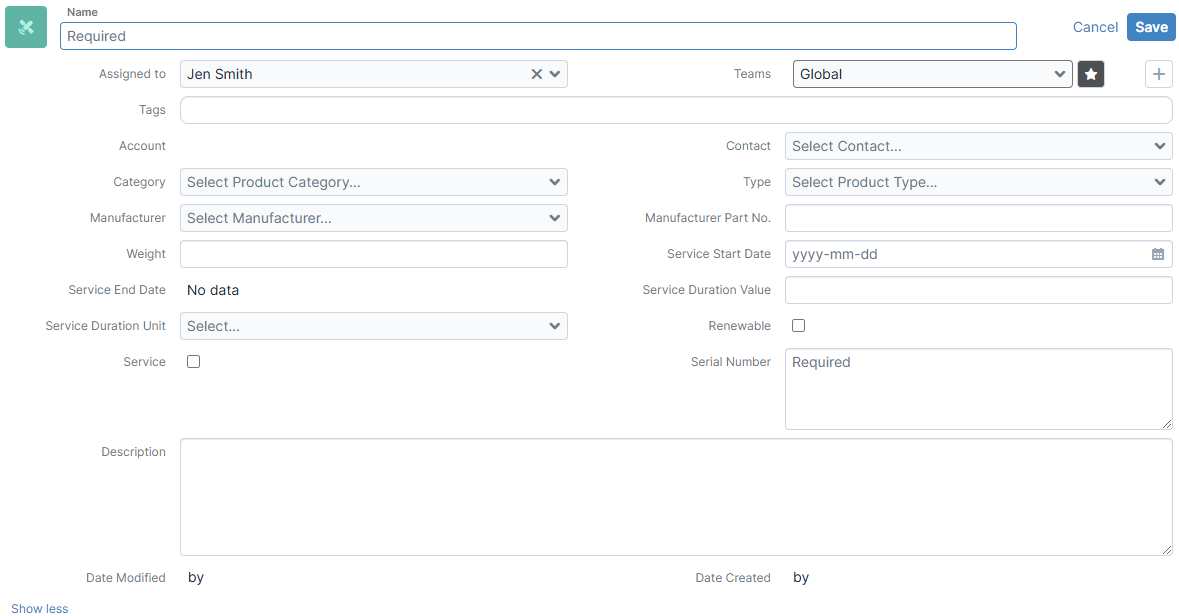
Fill in the appropriate standard SugarCRM and specific spare parts fields, click the "Save" button. The following fields are mandatory:
- Name
- Serial Number
Inventory Locations
Module-specific Fields
- Location Number
- Location Type - selectable from a predefined list of values
- Location Address (with separated country, state, zip, city and street fields)
Inventory Locations List View
This view displays the actual list of inventory locations.

Subpanels
The following associated data are displayed as subpanels in list view (detailed in the "Subpanels" section):
- Business Centers
- Service Employees
- Inventory Stocks
Inventory Locations Record View
By clicking an inventory location in list view, the record view of the actual item shows up.

Create Inventory Locations
By clicking the "Create" button at the top in the inventory locations' list view, an input form shows up.
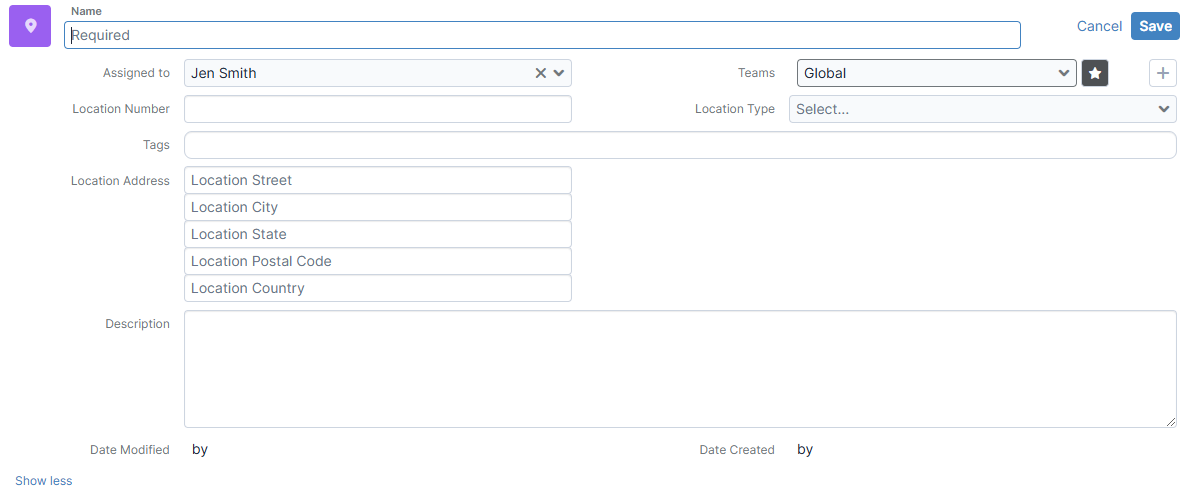
Fill in the appropriate standard SugarCRM and specific inventory location fields, click the "Save" button. The following fields are mandatory:
- Name
Inventory Stocks
Module-specific Fields
- Product (represented on the UI with its name)
- Inventory Location (represented on the UI with its name)
- Stock amount - fixed-type number
- Unit Of Amount
- Location Address (with separated country, state, zip, city and street fields)
Inventory Stocks List View
This view displays the actual list of inventory stocks.

Subpanels
The following associated data are displayed as subpanels in list view (detailed in the "Subpanels" section):
- Inventory Movements
Inventory Stocks Record View
By clicking an inventory stock in list view, the record view of the actual item shows up.

Create Inventory Stocks
By clicking the "Create" button at the top in the inventory stocks' list view, an input form shows up.

Fill in the appropriate standard SugarCRM and specific inventory stock fields, click the "Save" button. The following fields are mandatory:
- Name
- Stock amount
- Unit Of Amount
Inventory Movements
Module-specific Fields
- Movement Type - selectable from a predefined list of values
- Location From (>> Inventory Location - represented on the UI with its name)
- Location To (>> Inventory Location - represented on the UI with its name)
- Amount
- Unit Of Amount
Inventory Movements List View
This view displays the actual list of inventory movement.

Inventory Movements Record View
By clicking an inventory movement in list view, the record view of the actual item shows up.

Create Inventory Movements
By clicking the "Create" button at the top in the inventory movements' list view, an input form shows up.
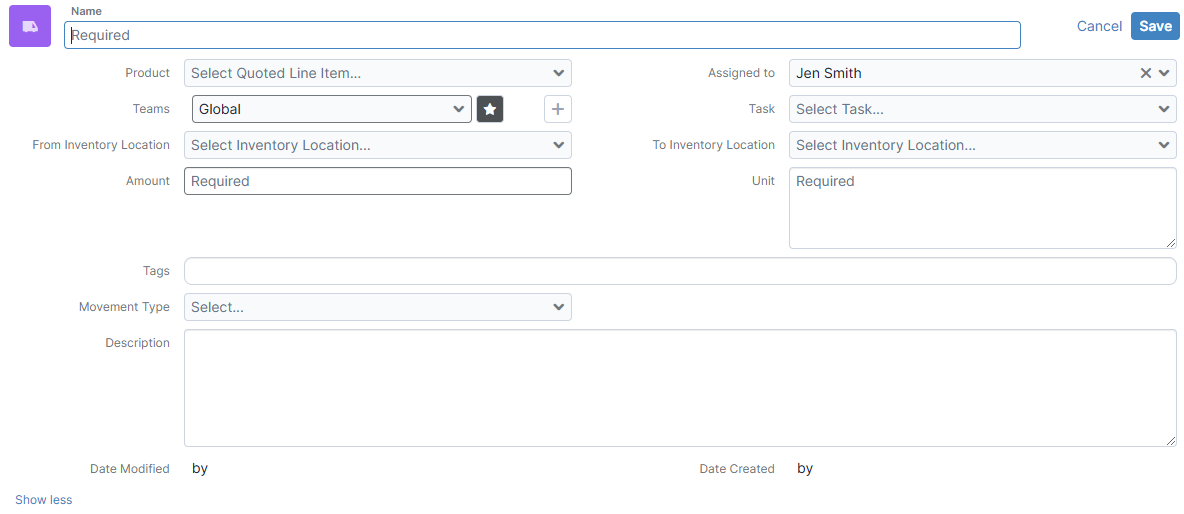
Fill in the appropriate standard SugarCRM and specific inventory stock fields, click the "Save" button. The following fields are mandatory:
- Name
- Amount
- Unit Of Amount
Service Employees
Module-specific Fields
- SugarCRM User (represented on the UI with its name)
- Business Center (represented on the UI with its name)
- Employee Skills - selectable from a predefined list of values; multiple choices possible
- Active Visit? (yes / no)
Service Employees List View
This view displays the actual list of service employees.

Subpanels
The following associated data are displayed as subpanels in list view (detailed in the "Subpanels" section):
- Tasks (assigned to the actual employee)
- Inventory Locations
- Service Recordings
- Service Locations
Service Employees Record View
By clicking a service employee in list view, the record view of the actual item shows up.

Create Service Employee
By clicking the "Create" button at the top in the service employees' list view, an input form shows up.

Fill in the appropriate standard SugarCRM and specific service employee fields, click the "Save" button. The following fields are mandatory:
- Name
Service Recordings
Module-specific Fields
- Service Employee (represented on the UI with its name)
- Task (represented on the UI with its name)
- Employee's (represented on the UI with its name)
Service Recordings List View
This view displays the actual list of service employees.

Service Recordings Record View
By clicking a service record in list view, the record view of the actual item shows up.

Create Service Recordings
By clicking the "Create" button at the top in the service recordings's list view, an input form shows up.

Fill in the appropriate standard SugarCRM and specific service recording fields, click the "Save" button. The following fields are mandatory:
- Name
Dispatcher
Business Center Selection
At the first step, a list of business centers are shown.
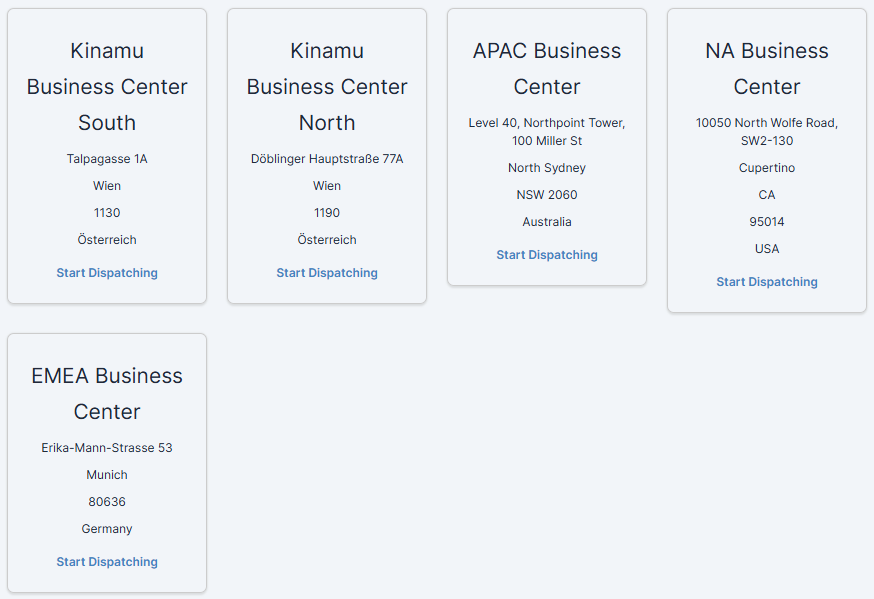
The user must select a business center to work with.
The Tasks List and the scheduler timeline
According to the selected business center, a scheduler screen appears, containing a list of tasks able to schedule (with a valid due date) and a timeline of assigned tasks.

Assign Task To A Service Employee
The task list items are draggable and can be dropped to the timeline. Just drag a task row in the task list and drop above the timeline. Tasks can overlap in time.
Preview the inner data of the assigned tasks
Just click on an assigned task and its data is shown on a preview panel.
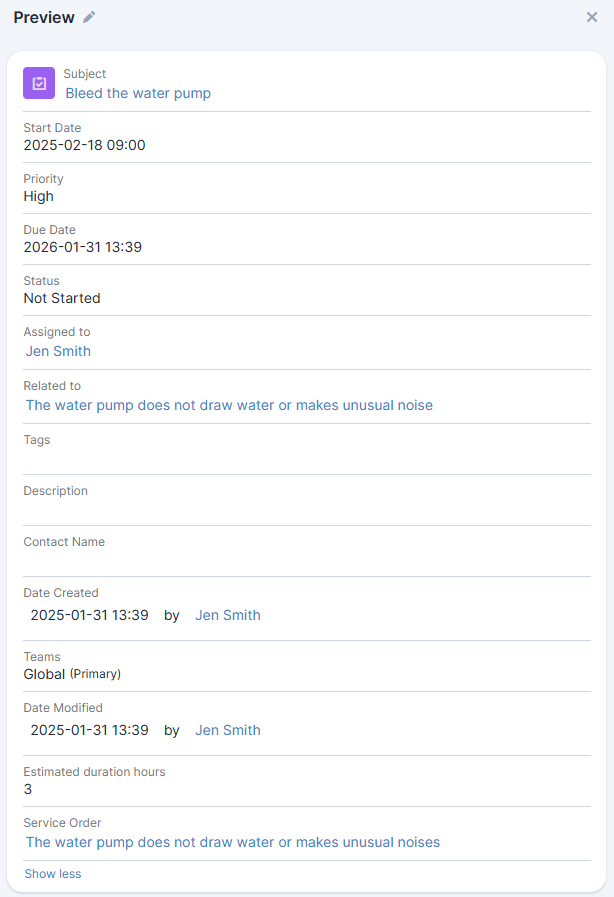
Rearrange tasks on the timeline
Assigned tasks can be rearranged on the timeline. Simply drag the appropriate task item on the timeline and drop to another location.
Delete Tasks From The Timeline
The task associations can be removed. To do that, click on the x-sign on the right side of the appropriate task on the timeline.
Field Service Management Tree View
The Accounts module has a special header button, named "Field Service Data" in its record view.

By clicking this button, a hierarchical structure is shown between certain elements related to the actual account.

Data Shown On Tree View
The data involved in the hierarchy display are:
- Member accounts
- Equipments
- Service agreements
Preview Related Data Of A Tree Node
The data containing the tree nodes (account, equipment or service agreement) can be previewed on a preview panel. To achieve this, click on the eye icon next to the appropriate element.
Scheduler - Automatic Service Order And Task Creation
The Kinamu Field Service Management addon has a scheduler module which can automatically create service orders and SugarCRM tasks for periodically recurring service events. This process is built up by the cooperation of the following SugarCRM core modules and Kinamu Service Management modules:
Service Orders
The service order is the central element of the field service management flow, through which the service process' inventory and task management can be administered and tracked.
Tasks
Tasks define the atomic level operations to be performed in the field service flow.
Task Templates
Task templates are the abstraction of the tasks, automatically created tasks are built from task templates.
Equipments
Equipments are the objects of tasks (the maintained products). They display the products covered by the service agreement in the system. Equipments can be assigned to one or more service plans, and with the help of task templates linked to the service plans, the automation creates the necessary service order and its underlying tasks, which must be performed on the associated equipments.
Service Agreements
Service agreements define the validity parameters related to the service agreement, and together with the service plans, it defines the parameters for automatic task creation. Without a valid service agreement and one or more service plans, no automatic task creation occurs. Validity is defined by the following properties:
- Service Start Date. The earliest date from which the contract is considered valid and the service order and its underlying tasks can be automatically created.
- Service End Date. The latest date until which the contract is considered valid and the service order and its underlying tasks can be automatically created.
- First Date Of Service. The contract is considered valid from the start date, but the automatic creation of the service order and its underlying tasks can begin later if this date is set.
- Agreement Status. Only agreements with an active status can trigger automatic service order and task creation.
- Agreement Expired? A flag that indicates whether a service agreement is expired or not. Can be set manually, but the scheduler sets it also automatically according to the validity period given by agreement's end date.
The creation of upcoming service orders and tasks (for all service agreements) occurs automatically once per day but can also be triggered manually for a specific service agreement. For a given service plan and equipment, a service order and its associated tasks are only created once per specific day, ensuring they do not multiply even if the process runs multiple times.
Service plans
Service plans define the period and frequency at which the automatic creation of service events is triggered. The rules of triggering are defined by the following properties:
- Last Service Time. The most recent service date. If known, the dates of the next maintenance tasks are calculated from this date. If more time has passed since the last maintenance than the period interval (meaning a scheduled maintenance was skipped), the related tasks will be automatically created starting from the given date.
- Lead Time. Automatic task creation can be linked not only to a single upcoming maintenance event but also to all scheduled periods within a given time interval. The Lead Time specifies how many days in advance, relative to the current date (while considering validity rules), the recurring tasks should be created in the future. Zero value means that this time window is restricted to the current day.
- Service Every. The automatic service order and task creation repetition period, specified with a metric and unit of time (days / months / years).



